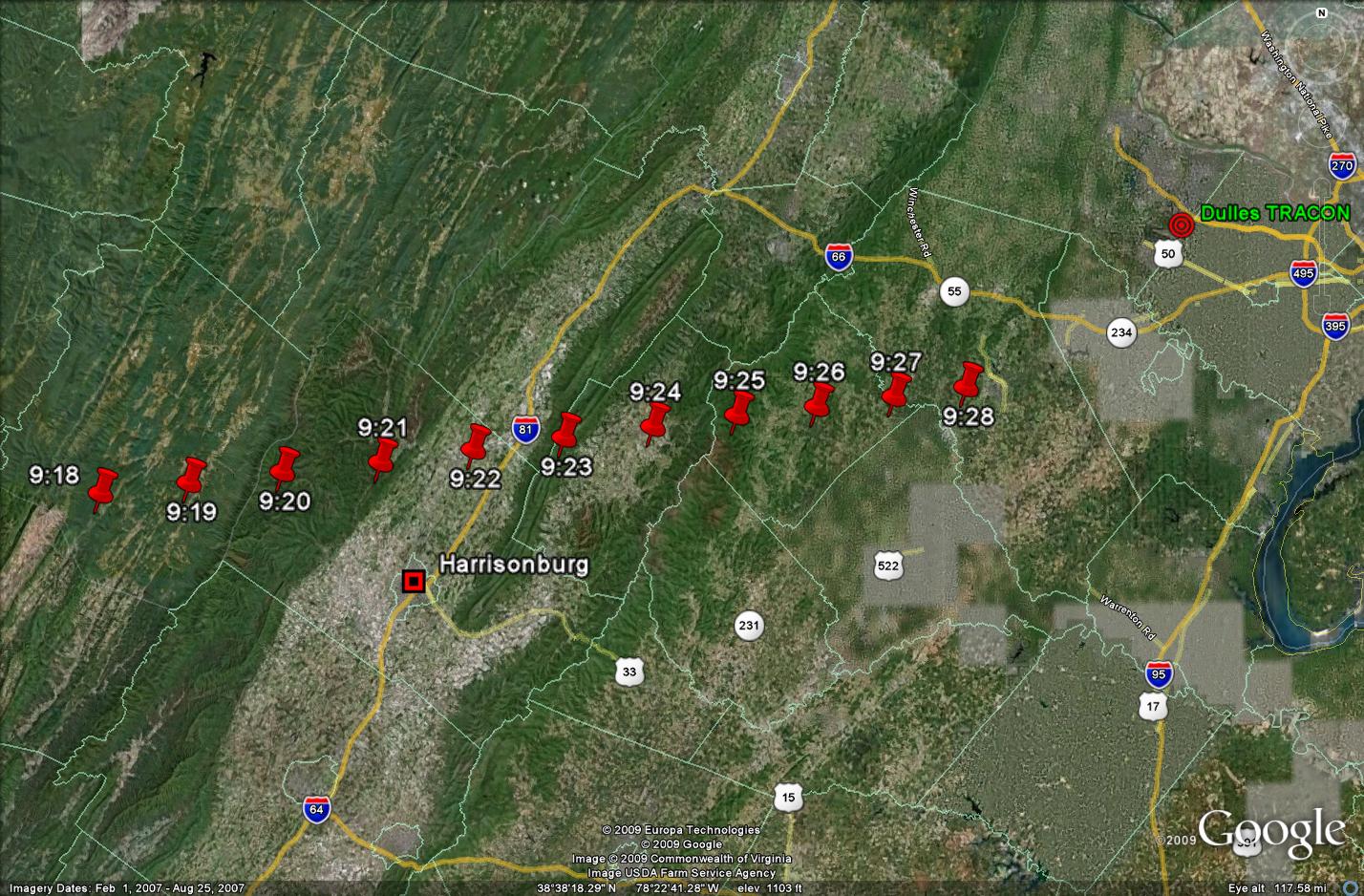Addendum added February 6, 2014
My recall of the arrangement of transponder knobs on American and United planes, below, is not accurate. Here is what I wrote in November 2003 in Commission MFR 04017215.
“The transponders on United B757 and B767 airframes are identical. The transponders on American B757 and B767 are also identical and differ from the United version in a single detail. There are four knobs on the American version that change the transponder code. There are only two on the United Version [sic]. In both versions the knobs are stacked in groups of two. Therefore, there are two stacks of two knobs each on the American version and one stack of two knobs on the United version. In all cases the upper knob is smaller than and easily distinguished from the lower knob.” The following paragraph in the MFR is redacted, “9/11 Closed by Statute.”
Addendum added Nov 20, 2009
Here is a slide version of this article. Slides are timed and will advance automatically. Included are screen prints of a Google Earth plot and data from the FDR, as well as a brief summary slide. Embedded audio not yet active; working on it.
American Air Flight 77 ZDC ZID Slide Show
Original article
In my original “Transponders and Ghosts” article I wrote: “Plane by hijacked plane, each transponder manipulation presented a different problem set to air traffic control, to managers of the National Airspace System and ultimately, to the National Command Authority.”
To briefly summarize, the four transponders on the hijacked airplanes were each manipulated differently. Three were turned off at distinctly different times in the flight paths of those planes and a fourth, the transponder on UA175, was changed to a different code.
We now have more insight into the problem that latter manipulation caused. I hasten to add that we have no direct knowledge of the hijacker tactics concerning the transponders; what we do know is that retrospectively the tactics, planned or serendipitous, were effective.
AA77, itself a ghost
At 9:18 the Operations Supervisor at Washington Center, ZDC, Cary Johnson, called Indianapolis Center, ZID. The call can be heard at this link. ThomasJohnson He reported that he had observed on TSD (Traffic Situation Display) that AA 77 was a ghost somewhere over Indiana and asked if ZID was working the aircraft. The Operations Supervisor at ZID, John Thomas, told Johnson that AA 77 had been reported lost but may have turned around and was heading somewhere else.
During the course of the conversation the two managers established that they were looking for an aircraft at last altitude of 35,000 feet, and that ZID had initiated rescue procedures.
ZDC
After concluding the ZID call Thomas convened a conference call with his Area Supervisors; that conversation began shortly before 9:22 and lasted less than one minute. The call can be heard at this link. johnsonarea They agreed they were looking for an aircraft with a limited data tag and one with a transponder code change. The reference was to AA 77 at 35K feet and UA 175 over New Jersey at 31K feet.
UA 175
In the “Ghosts” article we established that concurrent with the impact of AA 11 into the North Tower the transponder code on UA 175 was changed, and then changed again. The code was first changed to 3020 and then to 3321. There is a logical explanation for that sequence.
When the Commission Staff visited the “Companies,” American and United Airlines, we were provided in-cabin and in-cockpit orientations on both B757 and B767 aircraft at each Company. While in the B767 cockpit with the United senior pilot I had him show me the transponder and change the code. His technique was a two-step sequence. On the first step he changed the first and third digits, the second and fourth defaulted to zero. On the second step he changed the second and fourth digits.
At the time, United transponders had four knobs in two stacks of two each. The American transponders had four separate knobs. [See addendum of February 6, 2014 at the beginning of this article.] In retrospect, that is my best explanation for why the transponder code on UA 175 changed, and then changed again.
Among others, FAA’s Eastern Region knew of the code change and it was Eastern Region, not Herndon Center that was advising the air traffic control operations managers. We will return to that point later, but first back to ZDC.
ZDC, Continued
At no time did ZDC managers and supervisors discuss or did Johnson direct activating the primary switches on their scopes. ZDC never looked for and never recognized a primary only target approaching the nation’s capital from the west. By then, it was too late. The time was approaching 9:23 and a very real ghost, AA 77 was upon them and had begun a descent, not from flight level 35, but from flight level 25.
AA 77, Flight Data Recorder
According to the flight data recorder, a primary source, AA 77 left 35000 feet altitude at 9:01 soon after the hijackers took over. By 9: 14 it was at flight level 25,000 and remained there during the course of the air traffic control conversations between ZDC and ZID and among the area supervisors at ZDC. About 9:22 it began its final descent and by 9:29 it was below 10,000 feet altitude.
Given that primary source data and given the instructions the ZDC operations manager passed to his area supervisors, ZDC had no chance to detect AA77. Moreover, it was quickly moving into IAD (Dulles Tracon) air space as we shall see by considering another primary source, radar files from the 84th RADES.
AA 77, radar track.
NEADS radar reacquired AA 77 shortly before 9:10, but as a primary only track. Moreover, as opposed to the situation with AA 11 where NEADS could have determined altitude it could only have done so for AA 77 during the period 9:16 and 9:27 while the Oceana Radar was acquiring the aircraft. Thereafter, the radar feed was coming from The Plains, Virginia, the only radar in the Joint Surveillance System that could not provide altitude information on a primary only track. Shown here is a Google Earth plot of 84th RADES files from The Plains radar for the period 9:18 to 9:28.
According to the plot, AA 77 was just approaching Virginia, west of Harrisonburg, while Thomas and Johnson were conversing, and was passing north of Harrisonburg and crossing I81 while Johnson was conversing with his area supervisors. At the same time, after crossing the mountains, Hani Hanjour began the descent from flight level 25 headed for air space controlled by Dulles TRACON, IAD.
We will address the IAD story later in a separate article. For now we need to document what is and is not happening in the hunt for AA 77.
Observables in real time
First, at no time do either Thomas or Johnson talk about or consider NEADS or military assistance.
Second, they are not taking their cues from or responding to Herndon Center. ZDC is responding to FAA’s Eastern Region, an administrative headquarters. Recall that we established in a previous article that the two entities fighting the battle (second article at link) that morning were NEADS and Herndon Center.
Third, at no time do Johnson and his Area Supervisors mention Dulles TRACON; they are concentrating on their mission which is handling transponding aircraft at high altitude.
Finally, ZDC does not turn on the primary switches on its scopes; instead they are looking for a limited data block, as was the case with UA 175. I made a separate, final trip to ZDC on the very point of primary switches to confirm that they did not turn them on. They did not.
A personal comment
We will likely never know the attack plan, in detail. What we do know is the Atta and al Shehhi had extended periods of quality time together, measured in days, weeks, even months, to discuss ‘what-ifs’, do research, and speculate what might and what might not work as they finalized the battle plan.
Certainly they had sufficient time and the means to determine that a transponder turned off over West Virginia might cause problems; to determine that a transponder changing codes might also cause problems; and that a low level approach to the nation’s capital might escape detection.
Given the primary source information, including the flight data recorder data, we can reverse engineer Hanjour’s actions and make some informed observations. First, Hanjour immediately changed altitude after takeover and turn around. Second, he flew erratically for several minutes after reaching his new altitude of 25,000 feet.
That erratic flight reinforces the belief by some that Hanjour and the other hijack pilots were unskilled. Conversely, it also reinforces the belief by others that the plot was planned in detail and was sophisticated. It is plausible that Hanjour flew erratically to encourage the passengers to stay seated and belted. Either way, Hanjour did level the plane and it flew smoothly at flight level 25 until it came time to descend.
It is a technicality of course, but during the period 09:24 to 09:27, AA77 was in Class E airspace, between 18,000 and 10,000 feet, airspace that ‘belonged’ to neither ZDC nor Dulles TRACON. Even so, Dulles TRACON controllers did ‘see’, but did not recognize the significance of a ‘no tag’ approaching during that time. And that’s the next story to be told.
Future articles
As mentioned, I will continue the primary source analysis of the approach of AA 77 through Dulles TRACON airspace and will establish using primary source information the earliest that the NCA would know it had an immediate problem.
It is also appropriate that we now queue up a discussion of Norman Mineta and his testimony. It is clear from this article that as of 9:20, no one knew where AA77 was or that it was approaching the nation’s capital; not ZID, not ZDC, not IAD, not Herndon, not the FAA Eastern Region and, above all, not FAA Headquarters, NEADS/NORAD, the NMCC, Richard Clarke, Norman Mineta, the Secret Service or the Vice President and President.
It will be the initiative of one person, Danielle O’Brien, that anyone, anywhere, will have actionable information. By that time, AA77 will be “inside the Beltway,” a term that used to enjoy a certain cachet.


One thought on “The Ghosts of 9-11: AA 77; a real ghost, unseen”
Comments are closed.